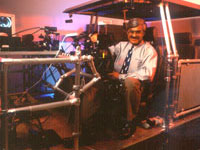|
Project: Human Centered Intelligent Driver Support
Systems
PI: Mohan Trivedi, Prof, Jacobs School of Engineering;
UCSD Leader, Calit2 Intelligent Transportation and Telematics
layer Funding: Nissan; UC Discovery Grant
Division: UCSD
Corporate Partner: Nissan Research
Start Date: May 2002
PDF: PDF
DOC: DOC
|

|
|
A steering wheel that begins vibrating if you're drowsy or take
your eyes too often off the road? That may sound far-fetched, but
it is one of many innovations under investigation as part of a wide-ranging,
$3-million project to improve auto safety by using state-of-the-art
technologies to reduce driver distraction.
Every year, more than one million Americans are injured and more
than 8,000 die on American roads - either directly or indirectly
- due to crashes resulting from driver distraction. Trivedi and
his colleagues in the newly created Laboratory for Intelligent and
Safe Automobiles (LISA) have already instrumented an Infiniti Q45
sedan with an array of cameras and sensors, and actuators for the
steering wheel and pedals to test sending vibrational signals to
the driver. The prototype driver-support system under development
provides information about events that show signs of potential interference
with a driver's intentions through sensory channels capable of processing
information even if the driver's visual and verbal attention is
overloaded. Primary focus is initially directed to the tactile channels,
but other modalities will be explored in the quest to create a new
"driving ecology" that manages drivers' attention rather than controlling
it.
"The driving wheel could begin vibrating to signal that the
driver isn't paying attention, and the strength of the vibration
would escalate to indicate the problem is getting worse. We
will also explore other modalities for intelligent driver-vehicle
interfaces. Our quest is to create what we call a new 'driving
ecology' that manages a driver's attention rather than controls
it."
- Mohan Trivedi, Director, UCSD Computer Vision and Robotics
Research (CVRR) Lab |
With the advent
of in-car "telematic" devices, this project aims to design
a system to support a driver in attention management, perception,
decision-making and control – and to do so, without shifting
too much of the burden of monitoring conditions to the car, thereby
making the driver feel he or she can pay even less attention. According
to Trivedi, the goal of the three-year project is to develop a "human-centered"
system that allows the vehicle to act as an extension of the driver's
cognition and that is aware of the driver's inherent attention limitations.
The system would also evaluate the state of the environment and
the driver in a manner consistent with the driver's perception of
criticality and performance.
To carry out the research, Trivedi put together a multidisciplinary
team of Calit2 academic participants, including Psychology's
Harold Pashler and Cognitive Sciences’ Jim Hollan, as well
as the Jacobs School’s Bhaskar Rao. Also contributing to the
research: Erwin Boer, a technical consultant and liaison between
the academic team and Nissan. The researchers are focusing on ways
to assess when there's a problem and how best to make the driver
aware of it. Initially, they will explore sensory channels capable
of processing information even if the driver's visual and verbal
attention is overloaded (such as touch).
Contact: Mohan Trivedi, (858) 822-0075, trivedi@ece.ucsd.edu
|

